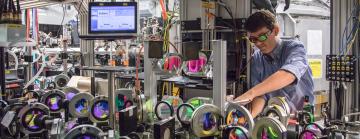SLAC brings rapid-fire laser and target expertise to national fusion energy research hubs
The lab will partner in two collaborations – one led by Colorado State University and the other by Lawrence Livermore National Laboratory – as part of a DOE-funded effort to speed up progress in fusion energy science and technology.
The U.S. Department of Energy’s SLAC National Accelerator Laboratory and Stanford University will partner with Colorado State University (CSU), Lawrence Livermore National Laboratory (LLNL) and other institutions in the creation of two inertial fusion science and technology hubs that were announced today by the DOE.
Following on last year’s fusion ignition breakthrough at LLNL’s National Ignition Facility, the hubs aim to accelerate foundational inertial fusion research and technology development toward a potential clean and abundant energy source. In total, $42 million was awarded to collaborations between universities, national laboratories and industry partners under the DOE’s Inertial Fusion Energy Science & Technology Accelerator Research (IFE-STAR) program.
Now that inertial fusion energy gain has been proven, the goal is to develop laser and target systems that can fire more often and produce more energy, according to SLAC and Stanford professor Siegfried Glenzer, deputy director of the internal fusion science and technology RISE hub, led by CSU and co-led by SLAC. SLAC is uniquely positioned to help reach that goal due to the lab’s expertise in developing and operating high-repetition-rate X-ray laser experiments at the Linac Coherent Light Source (LCLS). RISE will explore designs of inertial fusion energy concepts, pursue theory and experiments on laser fusion drivers and develop targets.
A second hub, the LLNL-led Science & Technology Accelerated Research for Fusion Innovation & Reactor Engineering (STARFIRE), will develop high-gain target designs, target manufacturing and solid-state laser technologies. As part of the STARFIRE hub, SLAC will provide detailed system requirements for various inertial fusion energy concepts, Alan Fry, project director for SLAC’s Matter in Extreme Conditions Petawatt Upgrade (MEC-U) said. The requirements will map closely to those being developed for the high-repetition-rate MEC-U laser, which will be coupled to LCLS and will also enable fundamental fusion science and technology.
The hubs establish broad, multi-institution teams that also seek to develop the future workforce by engaging students and partnering with universities and companies. RISE was awarded a four-year $16 million grant and has assembled experts from five universities, two U.S. national labs, a federal lab and three companies. STARFIRE was awarded a four-year $16 million grant and brings together seven universities, four U.S. national labs, an international lab, three commercial entities, one philanthropic organization and three private companies.
LCLS is a DOE Office of Science national user facility. IFE-STAR is supported by the DOE Office of Science Fusion Energy Sciences Program.
For more information, read IFE-STAR articles by CSU and LLNL.
Contact
For questions or comments, contact the SLAC Office of Communications at communications@slac.stanford.edu.
About SLAC
SLAC National Accelerator Laboratory explores how the universe works at the biggest, smallest and fastest scales and invents powerful tools used by researchers around the globe. As world leaders in ultrafast science and bold explorers of the physics of the universe, we forge new ground in understanding our origins and building a healthier and more sustainable future. Our discovery and innovation help develop new materials and chemical processes and open unprecedented views of the cosmos and life’s most delicate machinery. Building on more than 60 years of visionary research, we help shape the future by advancing areas such as quantum technology, scientific computing and the development of next-generation accelerators.
SLAC is operated by Stanford University for the U.S. Department of Energy’s Office of Science. The Office of Science is the single largest supporter of basic research in the physical sciences in the United States and is working to address some of the most pressing challenges of our time.







